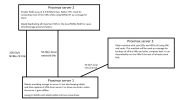Hello,
We purchased a server setup with 24 NVMes and GRAID card. We planned to use VMware and NVMe-OF, but as this option's support id being delayed by GRAID team, we decided to try to migrate to proxmox completely.
Proxmox is supported by GRAID (currently VE7 and they are limited to 5.x kernel with their driver).
We want to create fast and reliable setup. So my ideal plan is something like this:

What I am unsure of and with what I was sent here by GRAID team is the question how to replicate those VMs and how to keep everything safe. I know that for promxo replication to work,. I need ZFS, but can I run ZFS on a single virtual drive, when the data protection itself is handled and accellerated by the GRAID card on one end? On the server 2 there will be no GRAID. So I can use a NVMe raid controller or software RAID.
If this is not possible. Do you know if there is an option to copy those VMs frequently (only copy changes) so I can at least a pretty recent cold standby VMs ont he other server I can manually start if the main server dies?
On the machine where GRAID is currently installed for testing (HW of server 1 but running ubunut) I can get aroud 68GB/s for reads and 36 GB/s of writes shile sequential and I was able to to get around 10M IOPS while reading random. We do not want to loose that performance, so thats why iSCSI or NFS looks like bad options.
Thank you very much for your time and answers. This platform is new to me, so I am being forced to create a functional system with no previous expirience.
We purchased a server setup with 24 NVMes and GRAID card. We planned to use VMware and NVMe-OF, but as this option's support id being delayed by GRAID team, we decided to try to migrate to proxmox completely.
Proxmox is supported by GRAID (currently VE7 and they are limited to 5.x kernel with their driver).
We want to create fast and reliable setup. So my ideal plan is something like this:

What I am unsure of and with what I was sent here by GRAID team is the question how to replicate those VMs and how to keep everything safe. I know that for promxo replication to work,. I need ZFS, but can I run ZFS on a single virtual drive, when the data protection itself is handled and accellerated by the GRAID card on one end? On the server 2 there will be no GRAID. So I can use a NVMe raid controller or software RAID.
If this is not possible. Do you know if there is an option to copy those VMs frequently (only copy changes) so I can at least a pretty recent cold standby VMs ont he other server I can manually start if the main server dies?
On the machine where GRAID is currently installed for testing (HW of server 1 but running ubunut) I can get aroud 68GB/s for reads and 36 GB/s of writes shile sequential and I was able to to get around 10M IOPS while reading random. We do not want to loose that performance, so thats why iSCSI or NFS looks like bad options.
Thank you very much for your time and answers. This platform is new to me, so I am being forced to create a functional system with no previous expirience.

